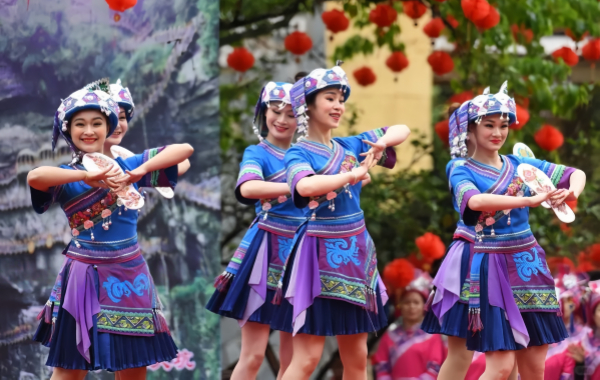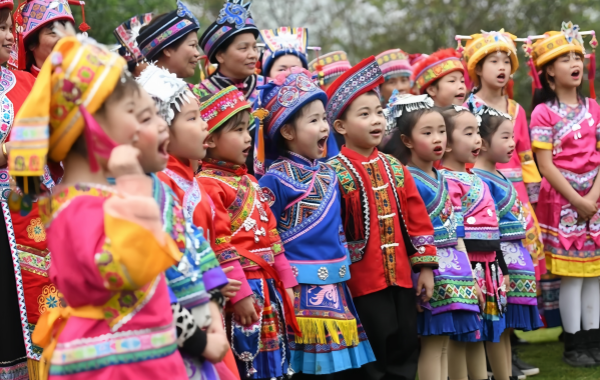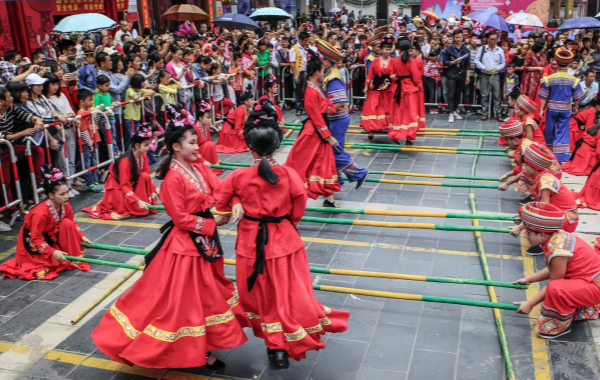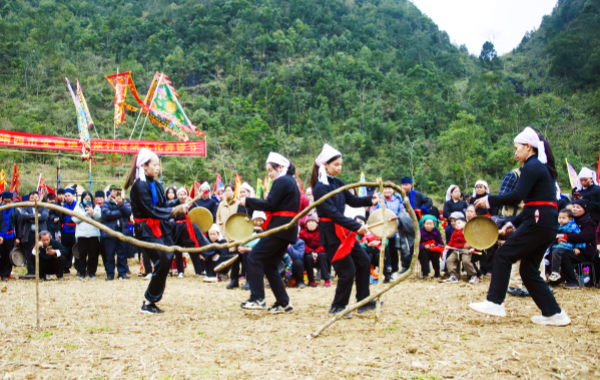Zhuang
Introduction

The Zhuang Nationality is the largest ethnic minority in China, known for its rich and unique cultural heritage. With a long history dating back thousands of years, the Zhuang people have developed a vibrant culture that encompasses music, dance, art, and traditional customs. They have a deep connection to the land, especially the fertile valleys and mountainous regions where they have lived for generations.
 History
History
▪ Origin
The ancestors of the Zhuang people can be traced back to the ancient Yue people who inhabited southern China. Over time, through a process of cultural integration and development, they gradually formed their own distinct ethnic identity. The Zhuang have a long history of living in the areas of present-day Guangxi and surrounding regions, engaging in agriculture and developing a unique social and cultural system.
▪ Development
During the various dynasties in Chinese history, the Zhuang people had different degrees of interaction with the central government. In some periods, they were granted certain autonomous rights, which allowed them to maintain and develop their own culture. The development of agriculture, handicrafts, and trade contributed to the prosperity of Zhuang communities. They also established their own local governance systems, with leaders playing important roles in managing social affairs and resolving conflicts.
▪ Modern Times
In modern times, especially after the founding of the People's Republic of China, the Zhuang people have enjoyed equal rights and opportunities for development. The establishment of the Guangxi Zhuang Autonomous Region has provided a platform for the preservation and promotion of Zhuang culture. The Zhuang people have actively participated in national construction and development, while also striving to maintain their traditional cultural heritage through various means such as cultural festivals, education, and tourism.
 Population
Population
▪ Quantity
As of the latest census data, the Zhuang population in China is approximately 18 million, making it the most populous ethnic minority in the country.
▪ Distribution
The Zhuang people are mainly concentrated in Guangxi Zhuang Autonomous Region, which is their largest habitat. In addition, significant Zhuang populations can also be found in neighboring Yunnan, Guangdong, Guizhou and Hunan provinces. Their wide distribution reflects their long history of migration and settlement in southern China.
 Economy
Economy
Traditionally, the Zhuang economy was based on agriculture, with rice cultivation being the main activity. The fertile land in Guangxi and other regions provided favorable conditions for growing rice and other crops. In addition to agriculture, the Zhuang people also engaged in fishing, hunting, and handicrafts such as weaving and pottery-making. In modern times, with the development of industry and services, the Zhuang economy has become more diversified. Many Zhuang people are now involved in manufacturing, tourism, and other modern industries, while still maintaining their traditional agricultural practices to some extent.
 Culture
Culture
▪ Language and Script
The Zhuang language belongs to the Tai-Kadai language family. It has several dialects, but they are generally mutually intelligible to a certain degree. In the past, the Zhuang people used Sawndip, a traditional character system based on Chinese characters, to record their language. Today, the standard Zhuang script is based on the Latin alphabet, which has been widely promoted and used in education, media, and official documents. Efforts are still being made to preserve and develop the Sawndip script as an important part of Zhuang cultural heritage.
▪ Religious Beliefs
The Zhuang people have a complex religious belief system. Polytheism is prevalent, with a belief in various gods and spirits associated with nature, such as the god of the mountains, the god of the rivers, and the god of the crops. Ancestor worship is also an important aspect of Zhuang religious culture, as the Zhuang people place great importance on family lineage and the memory of their ancestors. In addition, some Zhuang people have been influenced by Buddhism, Taoism, and Christianity, and these religions coexist with traditional Zhuang beliefs to some extent.
 ▪ Clothing
▪ Clothing
Traditional Zhuang clothing is colorful and distinctive, reflecting the local climate and cultural traditions. Women's clothing often features bright colors, intricate embroidery, and silver ornaments. The typical Zhuang women's outfit includes a short jacket, a long skirt, and a headscarf. Men's clothing is relatively simpler, usually consisting of a short-sleeved shirt and trousers. In different regions, Zhuang clothing may have some variations in style and decoration, but they all share a common aesthetic of beauty and practicality.
▪ Agriculture
Agriculture has been the cornerstone of Zhuang culture for thousands of years. The Zhuang people have developed advanced agricultural techniques suitable for the local environment, such as terraced farming in mountainous areas. They have a deep understanding of the seasons and agricultural cycles, and they celebrate various agricultural festivals to express their gratitude for a good harvest and pray for future prosperity. Agriculture not only provides food and livelihood for the Zhuang people but also shapes their social structure and cultural values.
▪ Literature
Zhuang literature has a long and rich history, including oral literature such as folk tales, legends, and songs, as well as written literature in the form of ancient inscriptions and modern literary works. Zhuang folk tales often feature mythical creatures, heroes, and moral lessons, reflecting the people's imagination and values. Zhuang songs, known as "Zhuang Ge," are an important part of Zhuang culture, with a wide range of themes including love, labor, and social life. These songs are often sung during festivals, weddings, and other social gatherings, and they have been passed down from generation to generation.
▪ Transportation
In the past, the Zhuang people relied mainly on water transportation, as many of their settlements were located near rivers and lakes. Boats were an important means of transportation for traveling, trading, and fishing. In mountainous areas, paths and trails were the main ways for people to move around. In modern times, with the development of infrastructure, the Zhuang people have access to modern modes of transportation such as buses, trains, and airplanes, which have greatly improved their mobility and connectivity with the outside world. However, traditional water transportation still plays a role in some rural areas, especially for tourism and local transportation.
 Science
Science
▪ Medicine
Traditional Zhuang medicine has a long history and is based on the use of local herbs and natural remedies. Zhuang healers, known as "Mo Yao," have a deep knowledge of the medicinal properties of plants and animals in their environment. They use a combination of herbal medicines, massage, and acupuncture to treat various diseases and ailments. Traditional Zhuang medicine emphasizes a holistic approach to health, considering the physical, mental, and spiritual well-being of the patient. In recent years, there has been growing interest in integrating traditional Zhuang medicine with modern healthcare systems to provide more comprehensive and culturally appropriate medical services.
▪ Calendar
The Zhuang people have their own traditional calendar, which is based on the lunar cycle and agricultural seasons. This calendar is used to guide agricultural activities, such as sowing, harvesting, and irrigation. It also marks important festivals and cultural events throughout the year. The Zhuang calendar reflects the close relationship between the Zhuang people and nature, as well as their deep understanding of the agricultural cycles and seasonal changes.
 Art
Art
▪ Music
Zhuang music is characterized by its unique melodies and rhythms, often accompanied by traditional musical instruments such as the bronze drum, the suona horn, and the zither. The bronze drum is a symbol of Zhuang culture and is used in various religious and social ceremonies. Zhuang music has a wide range of genres, including folk songs, instrumental music, and dance music. It expresses the people's emotions, experiences, and cultural values, and it plays an important role in Zhuang social life and cultural inheritance.
 ▪ Dance
▪ Dance
Zhuang dance is diverse and vibrant, with different styles and forms in different regions. Traditional Zhuang dances often mimic the movements of animals or depict scenes from daily life and agricultural activities. For example, the "Frog Dance" is a well-known Zhuang dance that imitates the movements of frogs, symbolizing fertility and good luck. Zhuang dances are usually performed during festivals, weddings, and other celebrations, bringing people together and creating a joyful atmosphere.
▪ Architecture
Traditional Zhuang architecture is adapted to the local climate and geographical conditions. In mountainous areas, Zhuang houses are often built on stilts to protect against floods and wild animals. The houses are usually made of wood and bamboo, with tiled roofs. The interior layout is designed for functionality and family life, with separate areas for sleeping, cooking, and storage. In some regions, Zhuang villages feature unique architectural styles, such as the "Dry-Ladder Building" in Chengyang, which is a famous example of Zhuang traditional architecture and has become a popular tourist attraction.
▪ Landscape
The Zhuang landscape is diverse and beautiful, ranging from lush valleys and rolling hills to towering mountains and clear rivers. Guangxi, the main habitat of the Zhuang people, is known for its stunning natural scenery, including the Guilin Mountains and Li River, which have inspired countless artists and poets throughout history. The natural beauty of the Zhuang landscape has not only provided a living environment for the Zhuang people but also served as a source of inspiration for their art, literature, and cultural creation.
▪ Arts and Crafts
Zhuang arts and crafts are renowned for their exquisite craftsmanship and unique styles. Traditional Zhuang crafts include brocade weaving, embroidery, silver ornament making, and wood carving. Zhuang brocade is a famous textile art form, known for its colorful patterns and high-quality materials. It is often used to make clothing, bedding, and decorative items. Zhuang silver ornaments are also highly valued for their intricate designs and cultural significance, and they are often worn by women during festivals and special occasions. These arts and crafts not only showcase the artistic talents of the Zhuang people but also reflect their cultural traditions and aesthetic values.
 Custom
Custom
▪ Etiquette
Zhuang etiquette is based on respect, politeness, and hospitality. When visiting a Zhuang home, guests are usually greeted warmly and offered tea or other refreshments. It is customary to remove one's shoes before entering the house as a sign of respect. Zhuang people also place great importance on social harmony and avoiding conflicts. They use polite language and gestures in their daily interactions, and they show respect to elders and guests.
▪ Marriage Customs
Zhuang marriage customs vary slightly from region to region, but they generally involve several stages, including matchmaking, engagement, and the wedding ceremony. In the past, arranged marriages were common, but now young people have more freedom to choose their partners. The wedding ceremony is an important event in Zhuang society, often accompanied by traditional music, dance, and feasting. The newlyweds are usually given gifts and blessings by family and friends, and they start their new life together with the support of the community.
 ▪ Festivals
▪ Festivals
The Zhuang people celebrate a variety of festivals throughout the year, each with its own unique customs and traditions. The Spring Festival (Chinese New Year) is an important festival for the Zhuang people, just like for other ethnic groups in China. During this festival, families gather together to have a reunion dinner, set off fireworks, and exchange gifts. The "San Yue San" Festival, also known as the "Singing Festival," is a traditional Zhuang festival celebrated on the third day of the third lunar month. On this day, young men and women gather in the fields or mountains to sing love songs and express their feelings. Other important festivals include the Mid-Autumn Festival and the Dragon Boat Festival, which are also celebrated with great enthusiasm by the Zhuang people.
▪ Diet
Zhuang cuisine is characterized by its bold flavors and the use of local ingredients. Rice is the staple food, and it is often accompanied by a variety of dishes made from meat, fish, vegetables, and herbs. Zhuang dishes often feature sour, spicy, and fragrant flavors, which are achieved through the use of ingredients such as chili peppers, garlic, ginger, and lemon leaves. Some famous Zhuang dishes include "Lemongrass Grilled Fish," "Sour Soup Chicken," and "Zhuang-style Rice Noodles." In addition to food, the Zhuang people also have a tradition of drinking tea and homemade wine, which are often served during social gatherings and festivals.
▪ Funeral Customs
Zhuang funeral customs are based on respect for the deceased and the belief in an afterlife. When a person dies, the family will hold a series of funeral rituals to mourn the loss and guide the soul of the deceased to the afterlife. The body is usually washed, dressed in new clothes, and placed in a coffin. Funeral prayers and offerings are made by family members and religious leaders. The funeral procession is often accompanied by traditional music and dance, and family and friends gather to pay their respects and offer condolences. After the funeral, there is usually a mourning period during which the family members refrain from certain activities and focus on remembering the deceased.
What Our Clients Say?
Based on 10,000+ traveler reviews











